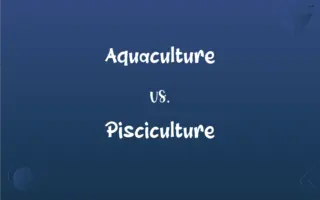Ahi vs. Mahi: What's the Difference?
Edited by Aimie Carlson || By Janet White || Published on December 12, 2023
Ahi refers to yellowfin or bigeye tuna, a popular sashimi fish, while mahi, or mahi-mahi, is a dolphin fish known for its firm texture and mild flavor.

Key Differences
Ahi is a term commonly used to describe yellowfin and bigeye tuna, primarily found in warm ocean waters. It's known for its rich, red flesh and is a favorite in sashimi dishes. Mahi, also known as mahi-mahi or dolphin fish, is not related to dolphins and is found in off-shore temperate, tropical, and subtropical waters worldwide. It's known for its firm texture and mild, sweet flavor, making it popular in various cooked dishes.
In terms of culinary use, ahi tuna is often served raw or lightly seared, highlighting its delicate texture and flavor. It's a staple in Japanese cuisine, especially in sushi and sashimi. Mahi, on the other hand, is commonly grilled, baked, or fried, and is known for its ability to hold up well to various cooking methods without falling apart, which is quite different from the typical preparation of ahi.
Nutritionally, both ahi and mahi are excellent sources of protein and contain beneficial omega-3 fatty acids. However, ahi tuna tends to have a higher fat content, contributing to its rich taste and texture. Mahi is leaner, with a lower fat content, making it a lighter option while still being flavorful.
In terms of environmental impact, both species face different challenges. Ahi, especially the bluefin variety, has been subject to overfishing, leading to concerns about sustainability. Mahi is generally considered a more sustainable choice, with healthy populations due to their fast growth and prolific breeding habits.
Comparison Chart
Species
Yellowfin or Bigeye Tuna
Dolphin Fish (not related to dolphins)
ADVERTISEMENT
Habitat
Warm ocean waters globally
Off-shore temperate, tropical, subtropical
Culinary Use
Often served raw or lightly seared
Commonly grilled, baked, or fried
Flavor and Texture
Rich, red flesh, delicate texture and taste
Firm texture, mild and sweet flavor
Nutrition
Higher in fat, rich in omega-3
Leaner, lower fat, still rich in omega-3
Sustainability
Concerns of overfishing, especially bluefin
Generally sustainable, fast-growing
ADVERTISEMENT
Ahi and Mahi Definitions
Ahi
In Hawaiian, 'ahi' means fire, a reference to the fish's color.
The ahi's vibrant red hue is reminiscent of fire.
Mahi
Mahi is known for its striking golden hues and elongated body.
The mahi's vibrant colors make it a visually appealing catch.
Ahi
Ahi refers to yellowfin or bigeye tuna, often used in sashimi.
The chef prepared a beautiful plate of ahi tuna for the appetizer.
Mahi
In Hawaiian, 'mahi-mahi' means very strong, referring to the fish's strength.
The mahi put up a good fight before we reeled it in.
Ahi
Ahi is a prized fish in recreational and commercial fishing.
Anglers often seek ahi for its challenging catch and culinary value.
Mahi
Mahi is a popular choice in tropical and subtropical cuisine.
Grilled mahi is a staple in many Caribbean dishes.
Ahi
Ahi is essential in Japanese cuisine, especially for sushi.
Sushi chefs highly value ahi for its taste and texture.
Mahi
Mahi, or mahi-mahi, is a surface-dwelling ray-finned fish.
We caught some mahi during our deep-sea fishing trip.
Ahi
In culinary contexts, ahi usually implies a high-quality tuna.
The restaurant's menu features ahi as its specialty dish.
Mahi
Mahi is considered a sustainable seafood choice.
I prefer to cook with mahi because it's an environmentally responsible option.
Ahi
Either of two types of tuna, bigeye tuna or yellowfin tuna, having edible flesh that is commonly grilled or served raw as sashimi.
Mahi
(NZ) the work required to complete a task
Ahi
Yellowfin tuna
FAQs
What is ahi?
Ahi refers to yellowfin or bigeye tuna, often used in raw fish dishes.
Can you eat ahi raw?
Yes, ahi is commonly eaten raw, especially in sashimi and sushi.
Is mahi a sustainable fish?
Yes, mahi is generally considered a sustainable seafood choice.
How do you cook ahi?
Ahi is best cooked seared or eaten raw to maintain its flavor and texture.
Is mahi good for grilling?
Yes, mahi's firm texture makes it excellent for grilling.
What's the best way to season mahi?
Mahi pairs well with citrus, herbs, and garlic for seasoning.
What is mahi?
Mahi, also known as mahi-mahi, is a type of dolphin fish, not related to dolphins.
What does mahi taste like?
Mahi has a mild, sweet flavor with a firm, moist texture.
Is mahi high in protein?
Yes, mahi is a great source of lean protein.
What does ahi taste like?
Ahi has a rich, slightly nutty flavor with a tender texture.
Where is ahi commonly found?
Ahi is found in warm ocean waters worldwide.
Where is mahi commonly found?
Mahi is found in off-shore tropical and subtropical waters.
How do you cook mahi?
Mahi can be grilled, baked, or fried, and is versatile in cooking.
How do you know when ahi is fresh?
Fresh ahi has a bright red color, firm texture, and mild ocean scent.
Is ahi high in mercury?
Ahi can have higher mercury levels, so consumption should be moderate.
What's the best way to season ahi?
Ahi is best with light seasonings like soy sauce, sesame oil, or just salt and pepper.
Can pregnant women eat ahi?
Pregnant women are advised to limit ahi intake due to mercury content.
How do you know when mahi is fresh?
Fresh mahi has bright skin, clear eyes, and a mild scent.
Can ahi be frozen?
Yes, ahi can be frozen, though it's best enjoyed fresh.
Can mahi be frozen?
Yes, mahi can be frozen and maintains its quality well.
About Author
Written by
Janet WhiteJanet White has been an esteemed writer and blogger for Difference Wiki. Holding a Master's degree in Science and Medical Journalism from the prestigious Boston University, she has consistently demonstrated her expertise and passion for her field. When she's not immersed in her work, Janet relishes her time exercising, delving into a good book, and cherishing moments with friends and family.
Edited by
Aimie CarlsonAimie Carlson, holding a master's degree in English literature, is a fervent English language enthusiast. She lends her writing talents to Difference Wiki, a prominent website that specializes in comparisons, offering readers insightful analyses that both captivate and inform.







































































